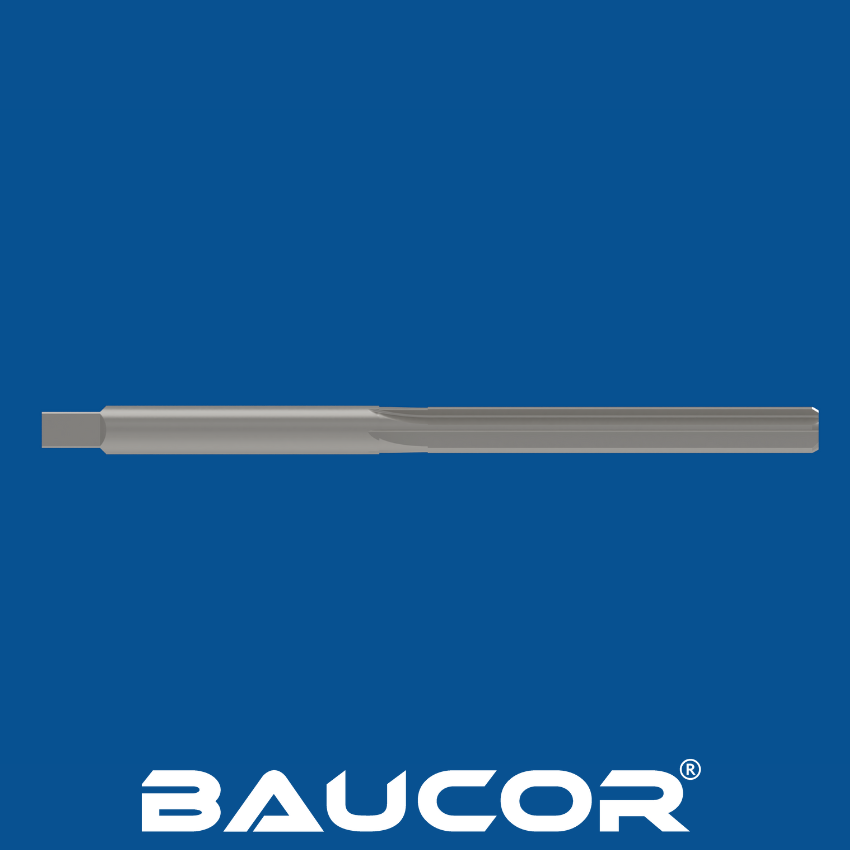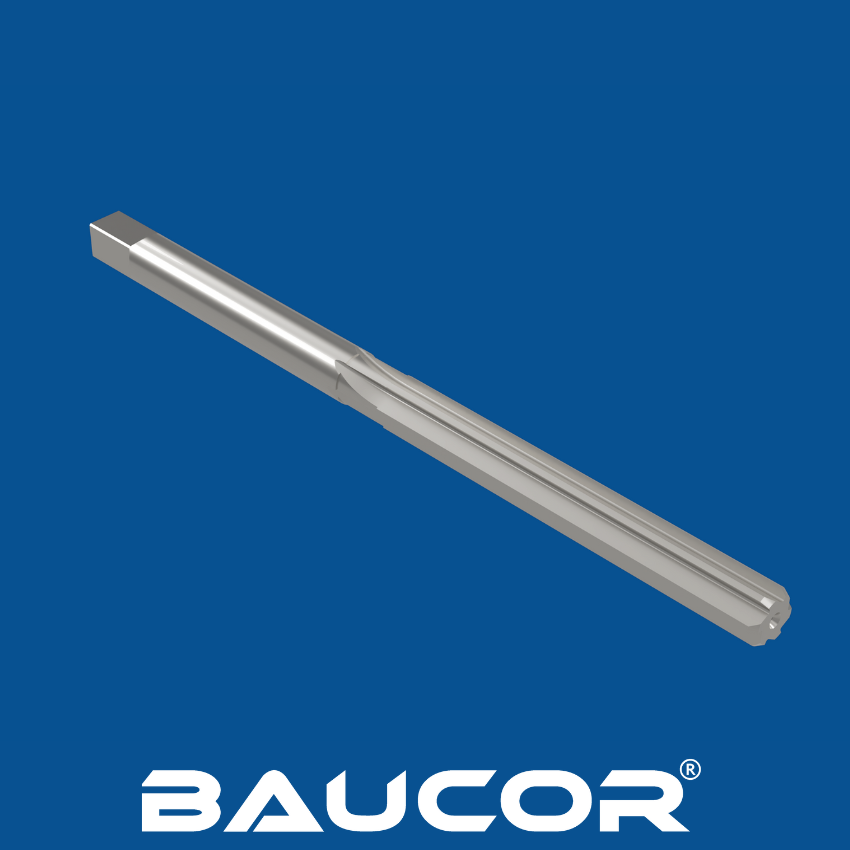EXPERIENCE THE BAUCOR DIFFERENCE.
DISCOVER PRECISION-ENGINEERED REAMERS THAT REDEFINE HOLE FINISHING.
EXPERIENCE THE BAUCOR DIFFERENCE.
DISCOVER PRECISION-ENGINEERED REAMERS THAT REDEFINE HOLE FINISHING.
Hand reamers are manually operated cutting tools used to slightly enlarge and precisely finish pre-existing holes in various materials. They are typically used when a higher level of accuracy and surface finish is required than can be achieved with a standard drill bit.
How Hand Reamers Work:
Cutting Action: As the reamer rotates, the cutting edges on the flutes gradually enlarge the hole to the desired diameter. The reamer's design ensures that it follows the existing hole, preventing it from wandering or creating an oversized hole.
Surface Finish: Hand reamers are designed to leave a smooth, precise finish on the inside of the hole, improving the fit and function of components that will be inserted into the hole.

Hand reamer manufacturing involves a series of precise steps to create a tool that delivers accurate hole finishing and a smooth surface. Here's an overview of the process:
Blanking:
Turning:
Milling or Grinding:
Heat Treatment:
Finishing:

Baucor offers a comprehensive range of sizes to accommodate various hole sizes and applications. Hand reamer sizes are typically specified by their diameter, which can range from very small (e.g., 1/16 inch) to relatively large (e.g., 1 inch or more).
Here's a possible range of hand reamer sizes that Baucor might manufacture:
Additional Considerations:
Custom Sizes: Baucor provides custom-made hand reamers with non-standard diameters to meet unique customer requirements.
Hand reamers are typically made from two main materials:
Besides High-Speed Steel (HSS) and Carbide, hand reamers can also be made from the following materials:
Less common materials for hand reamers include:
The choice of material depends on several factors, including the workpiece material, desired tolerances, production volume, budget, and required tool life. It's essential to consider these factors carefully to select the most suitable material for your specific application.

Similar to adjustable reamers, these can be expanded slightly to increase the hole size.

Reamers designed to be turned by hand, typically with a square drive.

Reamers with left-hand spiral flutes, used to prevent the reamer from pulling itself into the hole.

Reamers designed to be used in a machine, such as a lathe or milling machine.
Coatings significantly enhance the performance and lifespan of hand reamers by improving hardness, wear resistance, reducing friction, and promoting heat dissipation. Here's a comprehensive list of coatings commonly used on hand reamers:
PVD (Physical Vapor Deposition) Coatings:
CVD (Chemical Vapor Deposition) Coatings:
Other Coatings:
Choosing the Right Coating:
The best coating for a hand reamer depends on several factors:
Consulting with a tooling expert or reamer manufacturer can help you choose the right coating for your specific needs.
Hand reamers are versatile tools used in a variety of applications where precise hole finishing is needed but access to powered machinery might be limited or unnecessary. They are commonly used in the following areas:
Maintenance and Repair:
Manufacturing and Fabrication:
Hobbyist and DIY Projects:
Advantages of Hand Reamers:
Overall, hand reamers are versatile tools that find applications in various fields due to their precision, portability, and affordability. Their ability to create accurate and smooth holes makes them valuable for both professionals and hobbyists alike.
Hand reamers are versatile tools used across a wide range of industries for precise hole finishing. Their portability and ease of use make them valuable in applications where access to powered machinery might be limited. Here are some key industries that utilize hand reamers:
Overall, hand reamers are valuable tools in industries that require precise hole finishing and where access to power tools may be limited. Their versatility and ease of use make them indispensable for professionals and hobbyists alike in various fields.

Reamers with a pilot that guides the tool for accurate alignment.

Reamers with right-hand spiral flutes, used for general purpose reaming.

Reamers with a hollow cylindrical shape, often used with an arbor.

Reamers with spiral-shaped flutes that aid in chip removal.
Hand reamers, as the name suggests, are designed to be used manually, without the aid of any machine. They are operated by hand using a wrench or T-handle to rotate the reamer inside the hole.
While not used with machines in the traditional sense, hand reamers can be used in conjunction with a vise or clamp to secure the workpiece and provide stability during the reaming process. This helps ensure accurate and controlled hole finishing.
However, there are some tools that can be used to assist in the manual operation of hand reamers:
It's important to note that hand reamers are not typically used with powered machines like drill presses or milling machines. Their design and intended use are specifically for manual operation.

Reamers with straight flutes, used for reaming interruptions or keyways.

Reamers specifically designed to create holes for taper pins.

Reamers with a tapered shank for secure holding in a machine spindle.

Reamers designed to create tapered holes.
At Baucor, we are committed to providing our customers with more than just top-rated hand reamers. We are your dedicated partner in precision and performance, offering comprehensive design and engineering support to ensure you achieve the best possible results in your applications.
Our team of experienced engineers is here to collaborate with you, crafting custom hand reamers tailored precisely to your unique needs. We meticulously optimize reamer geometry, flute design, and material selection, ensuring the perfect balance of cutting performance and tool life for your specific application.
We understand that every application is different. That's why our engineers provide expert guidance on the best practices for using our hand reamers in your specific scenario. We offer recommendations on lubrication, cutting techniques, and tool maintenance, maximizing both tool life and the accuracy of your hole finishing.
Choosing the right material for your hand reamer is crucial. We offer expert advice on material selection, considering factors like workpiece material, desired hole tolerance, and frequency of use. Our recommendations for high-speed steel (HSS) or cobalt high-speed steel (HSS-Co) are always tailored to ensure optimal performance for your specific needs.
We stand behind our products. Our technical support team is always ready to assist you with any challenges you may face. We analyze worn or damaged reamers, identify the root causes of any issues, and recommend corrective actions to keep you running smoothly.
At Baucor, we believe knowledge is power. We offer a variety of training programs and resources, including online tutorials and manuals, to empower you with the knowledge needed to properly use and maintain your hand reamers. This ensures consistent results and helps you get the most out of your investment.
With Baucor, you're not just buying a tool; you're investing in a partnership dedicated to your success. Our commitment to customer satisfaction and our unwavering focus on quality make us a trusted partner in the manufacturing and repair industries.

BAUCOR offers custom manufacturing and engineering solutions tailored to your specific needs, across various industries.

BAUCOR's engineers can review your design and provide feedback to improve manufacturability, cost effectiveness, and efficiency.


Designing hand reamers involves considering several factors to ensure they produce precise holes with smooth finishes and maintain their cutting ability over time. Here are the key design guides:
Material Selection:
Flute Design:
Cutting Edge Geometry:
Diameter and Tolerance:
Overall Length and Shank Design:
Chamfer:
Additional Considerations:
By following these design guidelines, manufacturers can produce high-quality hand reamers that provide precise, accurate, and smooth hole finishing for a wide range of applications.